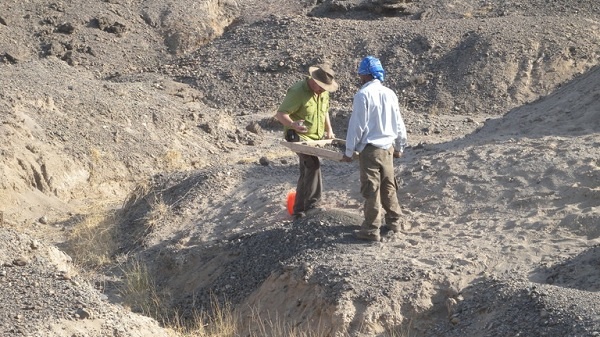
Bokol Dora 1 is near Lee Adoyta, Afar (Ethiopia), where in 2013 archaeologists found the fossil jaw bone of a human ancestor dating to about 2.78 million years ago.
By A’ndrea Elyse Messer (PSU)
UNIVERSITY PARK, PA – The origin of flaked-stone tool production is older than 2.58 million years ago, according to an international team of scientists working at the Bokol Dora 1 archaeological site in the Afar region of Ethiopia. Previously the oldest evidence of flaked-stone tools was younger than 2.58 million years ago.
“At first we found several artifacts lying on the surface, but we didn’t know what sediments they were coming from,” said Christopher Campisano, associate professor, School of Human Evolution and Social Change, Arizona State University. “But when I peered over the edge of a small cliff, I saw rocks sticking out from the mudstone face. I scaled up from the bottom using my rock hammer and found two nice stone tools starting to weather out.”
Bokol Dora 1 is near Lee Adoyta, lower Awash Valley, in the Afar region of Ethiopia, where in 2013 archaeologists found the fossil jaw bone of a human ancestor dating to about 2.78 million years ago.
Recently, stone tools for hammering, dating to 3.3 million years ago, were found in Kenya, but these are not flaked-stone tools. The process used to make flaked-stone tools, flint knapping, systematically chips off smaller sharp-edged tools from larger nodules of stone, creating tools suitable for scrapping, cutting and piercing. Earlier stone tools like those found in Kenya or those sometimes used by chimpanzees and monkeys are used to hammer and bash foods such as nuts and shellfish.
The archaeologists working at the Bokol Dora 1 site wondered how these flaked tools fit into the increasingly complex picture of stone tools production. These oldest artifacts, ascribed to the “Oldowan,” were distinct from the tools made by chimpanzees, monkeys and even earlier human ancestors.
“We expected to see some indication of an evolution from the Lomekwian (Kenya) to these earliest Oldowan tools,” said Will Archer, Max Planck Institute for Evolutionary Anthropology, Leipzig and the University of Cape Town. “Yet when we looked closely at the patterns, there was little connection to what is known from older archaeological sites or to the tools modern primates are making.”
Recovery of the flaked-stone tools took several years because the archaeologists needed to carefully excavate through many layers of sediment to reach the layer that contained animal bones and hundreds of pieces of chipped stone.
“These tools were dropped by early humans at the edge of a water source and then quickly buried,” said Vera Aldeias, interdisciplinary Center for Archaeology and Behavioral Evolution, University of Algarve, Portugal. “The site then stayed that way for millions of years.”
Kaye Reed, director of the Ledi-Geraru Research Project and research associate in the Institute of Human Origins, Arizona State, noted that the animal bones found with these tools are similar to those found a few kilometers away at Ledi-Geraru with the 2.78 million-year-old jaw bone.
Read the complete story at Penn State News
